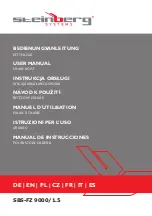
The friction brake is a load holding brake only and has
nothing to do with dynamic braking or rate of descent of a
load.
The brake clutch is splined to the primary sun gear shaft
between the motor and the primary sun gear. It will allow
this shaft to turn freely in the direction to raise a load and
lock up to force the brake discs to turn with the shaft in the
direction to lower a load.
The hydraulic cylinder, when pressurized, will release the
spring pressure on the brake discs, allowing the brake
discs to turn freely.
Dual Brake System – Operation
When hoisting a load, the brake clutch which connects the
motor shaft to the primary sun gear, allows free rotation.
The sprag cams lay over and permit the inner race to turn
free of the outer race, see figure 2. The static brake
remains fully applied. The hoist, in hoisting, is not affect-
ed by any braking action.
When the hoisting operation is stopped, the load attempts
to turn the primary sun gear in the opposite direction. This
reversed input causes the sprag cams to instantly roll
upward and firmly lock the shaft to the fully engaged fric-
tion brake.
When the hoist is powered in reverse to lower the load,
the motor cannot rotate until sufficient pilot pressure is
present to open the brake valve. The friction brake with-
in the hoist will completely release at a pressure lower
than that required to open the brake valve. The extent to
which the brake valve opens will determine the amount of
oil that can flow through it and the speed at which the load
will be lowered. Increasing the flow of oil to the hoist motor
will cause the pressure to rise and the opening in the
brake valve to enlarge, speeding up the descent of the
load. Decreasing this flow causes the pressure to lower
and the opening in the brake valve to decrease thus slow-
ing the descent of the load.
When the control valve is shifted to neutral, the pressure
will drop and the brake valve will close, stopping the load.
The static brake will engage and hold the load after the
brake valve has closed.
When lowering a load very slowly for precise positioning
little or no oil flow actually occurs through the hoist motor.
The pressure will build up to a point where the brake will
release sufficiently to allow the load to rotate the motor
through its own internal leakage. This feature results in a
very slow speed and extremely accurate positioning.
The friction brake receives very little wear in the lowering
operation. Most of the heat generated by the lowering and
stopping of a load is absorbed by the hydraulic oil where
it can be readily dissipated.
7
Содержание BRADEN Gearmatic BG6A
Страница 2: ......






























